9. Carol (2015) dir. Todd Haynes
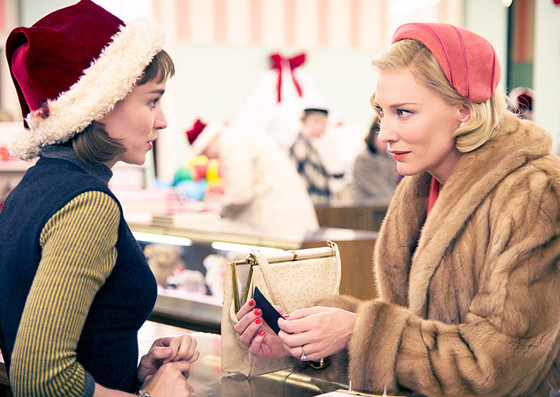
New Queer Cinema pioneer Todd Haynes premiered his ‘50s tale of lesbian lovers at the 2015 Cannes Film Festival, competing in the Palme d’Or section and taking home the Queer Palm, the jury noted that the film is “more than a movie, it’s a moment in history. The first time a love story between two women was treated with the respect and significance of any other mainstream cinematic romance. For its heartbreaking performances, stunning mise-en-scene, and overall mastery of craft we are proud to award CAROL with the Queer Palm.”
Indeed, there are generally three main directions lesbian storylines take – (1) so subtle you can miss it (2) so explicit that it causes outrage and controversy, e.g. Blue is the Warmest Colour (3) underground indie flicks that purposely don’t strive to achieve mainstream appeals, e.g. The Watermelon Woman, But I’m A Cheerleader. But Carol stands out for being a pure, sophisticated romance between women whose lives are domineered by patriarchal threats. It’s important that this film is mainstream, with extremely acclaimed actresses taking the lead.
The period drama’s expanding audience and public dissemination led to more people witnessing a piece of queer cinema not shadowed by rumoured exploits and having the appeal to satisfy many. Personally, I know multiple people who have been introduced into the world of queer cinema through this film and were pleasantly surprised that they enjoyed it.
Therefore, managing to pique people’s perceptions of what gay-themed cinema is and that these films aren’t all experimental arthouse flicks with a lots of confronting nudity. The essence at heart can be described through a conversation which appears in the film;
Therese: Have you ever been in love with a boy?
Richard: No!
Therese: But you’ve heard of it?
Richard: Of course, I mean have I heard of people like that. Sure.
Therese: I don’t mean people like that. I just mean, two people who fall in love with each other, say, a boy and a boy, out of the blue.
Richard: I don’t know anyone like that… But I’ll tell you this, there’s always some reason for it. In the background.
Therese: So, you don’t think it could just… happen to somebody? Anybody?
Richard: No, I don’t. What are you saying? Are you in love with a girl?
Set at a time where gay still meant carefree, and pride had no rainbow connotations, Carol represents what was lost (or more accurately, never had) for the lesbian community; that is: representation during the golden age of Hollywood. Partially due to the infamous Hays Code (a.k.a. the Motion Picture Production code that was applied to most US motion picture releases by major studios from 1930 to 1968), one of the strict “don’t” on the list was ‘any inference of sex perversion’.
And we all know that anything other than the standard heteronormative culture would be denied along the lines of that excuse. So, here we are in 2015 finally getting the ‘50s drama that so many lesbians at the time missed out on the opportunity of watching, and most importantly- feeling that they’re not alone.
Of course, with the development of lesbian pulp exploitations were soon making their way to America in the late ‘60s (e.g. Chained Girls, The Girl with the Hungry Eyes, Bad Girls Go to Hell), the code soon ended. But left the branded taboo of its ‘filthy’ content.
Carol follows the relationship between Carol Aird (the immensely elegant Cate Blanchett) and the younger Therese Belivet (Rooney Mara styled with an Anna Karina Bande á part fringe) as they struggle through the homophobic early ‘50s context, Carol’s difficult divorce proceedings with her soon-to-be ex Harge (Kyle Chandler) and his spying agents longing to get some dirt on her so that Harge can take Carol’s maternal rights of her adorable daughter, Wendy, away under a ‘morality clause.’
Full of opulent fashion, triple Academy Academy Award winning costume designer Sandy Powell effortlessly replicates the elegantly classic looks of the time period. Having previously worked with Blanchett on Scorsese’s The Aviator, transforming her into the blessed Katherine Hepburn, and again for Branagh’s Cinderella, these collaborations surely worked in their favour as each piece of clothing that Carol adorns emanates an aura of femme suave, cool sophistication, and stifled New Jersey wife.
Having worked with Neil Jordan, Derek Jarman, John Cameron Mitchell and being a long-term collaborator with both Scorsese and Haynes, Powell’s knowledge of period costuming is extensive. Haynes’ other film “Far from Heaven” (2002), which also delves into themes of same-sex relationships and renewed visions of the fifties working outside of the code (the film mainly focuses on the growing relationship between Julianne Moore’s character and Dannis Haysbert’s – which was forbidden under Hays code for ‘miscegenation’), the period piece is also set in the wealthy suburbs on the 1950s.
Carol wears big pale-brown fur coats, leather gloves (which act as a Cinderella-esque plot device), spectacular jewellery sets, and red streamlined silhouettes are all out of vintage Vogue – literally. Powell specifically looked at Vogue and Harper’s Bazaar from the winter periods of 1952-1953 in concurrence of the film’s temporal backdrop.
Carol’s coral colour is of specific interest, her nails, her lipstick, her neat little scarves and perfectly perched hats – all match. She is always well put together despite the heavy turmoil of her divorce (which we must note, was significantly more rare and eyebrow-raising than it is today). Perhaps her style is the source of her courage, especially when she’s without her daughter.
The same can be said for Therese’s celluloid dreams. A budding photographer (whose only framed photo in her apartment is that of Carol) serves as her other major character mark. The film itself is shot in super 16mm, in order to evoke the time period. While sneakily watching Sunset Blvd. (1950) in the projectionist booth with her initial semi-boyfriend Richard (Jake Lacy) and his friend, Danny, who has already seen the flick multiple times, reveals a predominant theme that could be applied to most unspoken desires in LGBTQ+ cinema;
Danny: “I’m charting the correlation between what the characters say and how they really feel.”
The film is based on Patricia Highsmith’s 1952 romance novel The Price of Salt, partially inspired by her actual romantic relationship with the slightly older Philadelphia socialite Virginia Kent Catherwood in the 1940s. Catherwood went on to lose custody of her daughter after her homosexuality was used against her with a taped recording of her lesbian affair from her next door hotel room.
Sounds familiar, right? Highsmith released the first lesbian happy ending under the pseudynym Claire Morgan, and actively denied rumours that she was the authoress of the book for thirty-eight years until 1990 when she republished The Price of Salt, retitling it as Carol and finally signing her name to the milestone work. Highmore is also the authoress behind other film adapted classics; Strangers on a Train (1950), and The Talented Mr. Ripley (1955).
With a charmingly magical score by Carter Burwell, the film manages to host a rare lesbian sex scene that is sensual rather than sensationalised (I’m looking at you Kechiche and Park), the women never feel like they are subjects performing for the presence of the male gaze.
(Bonus: Haynes’ feature directorial debut “Poison” (1991) is a three-part exploration of AIDS-era queer subversions.)
10. Tomboy (2011) dir. Céline Sciamma
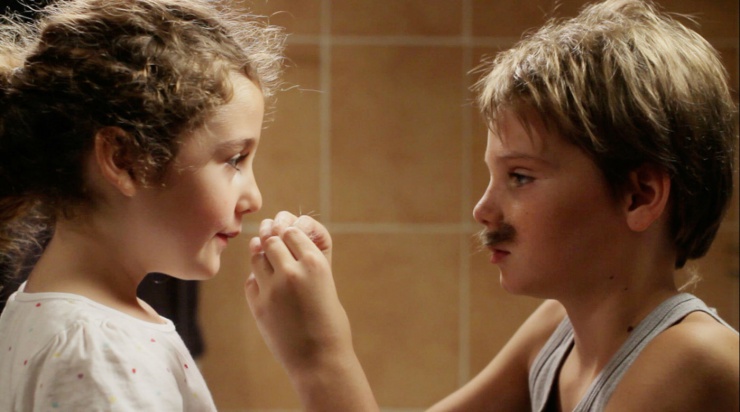
A French family move into a new neighbourhood. A fresh start for all members. According to cute little sister Jeanne (Malonn Levana); their father works on the computer, their mother can’t work because of her “big belly” i.e. she’s pregnant, and her older brother Mickäel is supremely cool and protects her from other kids.
Except, Mickäel is just the made-up name of Laure’s male persona. Or rather, Laure is the feminine persona of her Mickäel. Portrayed by the perfectly cast Zoé Héran, Laure first becomes Mickäel when another ten-year-old girl Lisa (Jeanne Disson) mistakes her for a boy- using the French pronoun that infers her expectation for a male name.
A reasonable assumption to make given Laure’s somewhat masculine appearance; her hair cut short and far away from puberty, the way ‘she’ holds herself is very ‘he’. Laure’s even skinny enough to pull off playing shirts vs. skins football with her new male friends shirtless. Everyone’s none the wiser. Suspended between genders, she thrives on the masculine. Her happiness blooms as the mutual crush with Lisa develops, while also continuously pushing herself more and more to give off the appearance that she is a ‘real’ boy.
Her mother gives her a pink lanyard with a key. She swaps the pink for a white shoe lace.
She cuts her red one-piece bathing suit into speedos. Her sister and her sculpt play-doh and she makes a phallic-like model to stuff into her new swimsuit. Adopting spitting mannerisms from other boys and being attentive and cautious every time she needs to pee, all of it is more than worth it for the couple of hours of play where fantasy is reality. But, the sorrowful way she looks in the mirror leaves a bitter taste. We wish she could be who he was meant to be. We hope it doesn’t turn into Boys Don’t Cry (1999).
Jeanne provides a perfect example of acceptance, unconditional love and child-like pride for Mickäel. Her innocence and naivety as to why anyone would get upset with Laure being Mickäel has yet to be stained by societal norms. Instead, she lives in a pretty pink world with a new-found brother who she can count on and lets her cut his hair.
The coming-of-age film is perhaps the only depiction of transsexuality within a child. Shocking considering, transgender people often start experiencing feelings of gender discordance at these ages, making it imperative for more cinema to represent the inner struggles at such a tumultuous time.
(Bonus: Céline Sciamma also directed lesbian-themed Water Lilies (2007; Naissance e Pieuvres).
11. The Handmaiden (2016) dir. Chan-wook Park
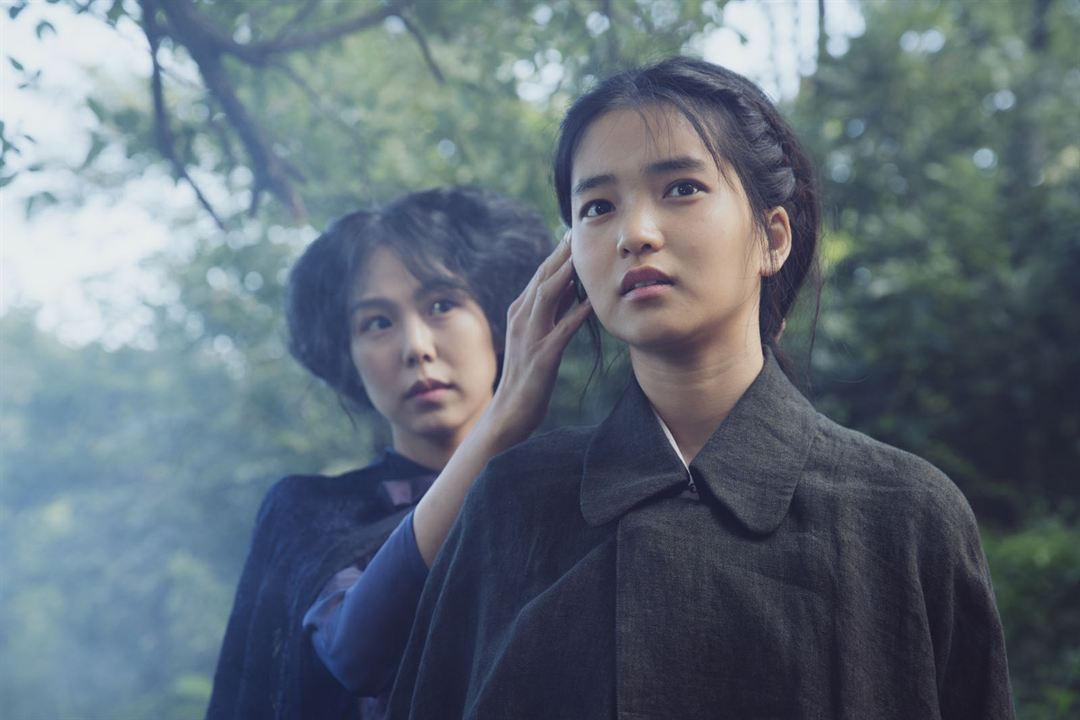
Chan-wook Park’s psychological thriller is a puzzle that is divided into three parts, each taking the perspective the perspective of a different character. Inspired by Sarah Waters’ novel Fingersmith, the original setting of the book of Victorian era Britain was adapted to 1930s Korea under Japanese rule. We begin with Sook-hee (Kim Tae-ri), a young Korean pickpocket who is hired by conman “Count Fujiwara” (Ha Jung-woo) in his complex, orchestrated plan to steal an inheritance.
It goes like this: (1) operating under the new pseudonym Tamako (the translated Okju), Sook-hee becomes the handmaiden of a Japanese heiress. (2) the Count, who is already familiar with the Lady’s uncle and master Kouzuki (Cho Jin-woong), lays his charm on the Heiress with the plan to get her to marry him. (3) This is backed up by Sook-hee’s beguiling her new mistress- attempting to persuade her that the Count is the one for her. (4) When steps 1-3 go to plan and the Lady is “fully ripe” for the taking, they’ll marry. (5) After their marriage, the Count will commit her to an asylum- leaving her right-less and miserably incompetent while the Count steals her inheritance. (6) Sook-hee gets paid for her involvement. Simple enough, right?
However, the Count’s strategy did not take Lady Hideko’s (Kim Min-hee) pure beauty into account. Neither did he suspect that our female protagonists would take a particular liking to one another.
The puzzle starts with the edges. Corner pieces of cherry blossom soul-absorbing trees and aristocratic antiques. We think we know the entire plot of the film within the first eleven minutes – but what emerges is something else. Park cuts scenes into a narrative that doesn’t follow the strict temporal chronology, so when we see a scene and think it’s over – we are surprised by its postliminary continuation, say, half an hour later. Hence my puzzle metaphor: everything is shown to us in slivers. This puzzle piece is of an angry octopus. This other one that looks to belong in the middle is of a bell. Our puzzle has no pretty picture on the box to tell us how to arrange the chaos until the very end.
Sook-hee is impressed by the opulent luxury her mistress lives in. The prodigious tree-surrounded secluded mansion has three wings; a Western-style wing designed by an English architect, a traditional Japanese wing, and an annex that the Master has turned into a library. You see, Kouzuki is deeply invested in the art of literature. Specifically: rare erotic literature, which he auctions off to his Japanese collector associates after special readings which serve as previews to the antique merchandise.
The special readings once performed by Hideko’s aunt are now (and have since she was a child) her responsibility. She has to seductively read the lewd (but very eloquent) text and perform for an audience of concupiscent, libidinous men. Is it a wonder that she’s attracted to women (or more accurately: woman) in the face of this? Her uncle’s abuse goes even beyond these exploits, believing in the phrase: “Beauty is cruel by nature.”
The film’s artful cinematography is thanks to Park’s frequent collaborator Chung-hoon Chung, a man responsible for many beautiful films. There are rose petals in the bath, lollipops in their mouths, and puffs of blue smoke that can end it all.
The film competed for the Palme d’Or at Cannes and won the BAFTA for Best Film Not in the English Language.
(Bonus: The novel on which the film is based upon has also been adapted into Aisling Walsh’s two-part BBC miniseries Fingersmith (2005), starring Sally Hawkins and Elaine Cassidy. Described by Hannah Woodhead; “In this steamy costume drama, (Hawkins) plays consummate outsider Sue Trinder, a petty thief who becomes embroiled in a scheme to steal a fortune of a stifled heiress. It’s a sensitive slow-burn saga full of scandal and intrigue… Far from being a titillating exercise in outrage, Fingersmith is an uncommonly nuanced portrait of female sexuality”).
Literary References
– Hannah Woodhead. Little Voices. From Little White Lies no.73 (2018).
12. Pink Narcissus (1971) dir. James Bidgood
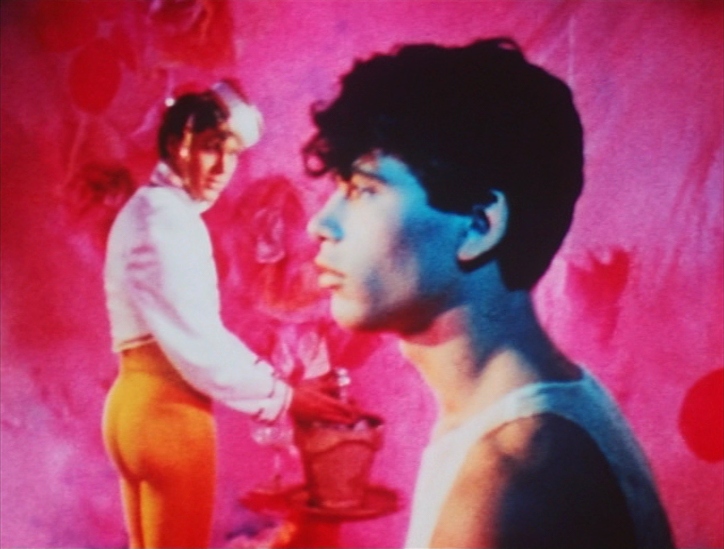
An 8mm fantasy full of pinks, purples and blues; this American arthouse flick has been described as “an erotic poem set in the fantasies of a young male prostitute” and worked with the tagline, “a unique experience in visual fantasy!” Indeed, Bidgood’s cult classic follows a nameless protagonist (the enigmatically unknown Bobby Kendall), who works as a gay male prostitute in New York as he escapes into the mystical imaginary at home. The 65 minutes is completely free of dialogue, paving way for an entirely focused canvas of aesthetic appeal that mirrors a photograph exhibition.
The otherworldly place of his fantasies is overrun by spider webs, jungle leaves and beautiful flowers. The moon is nearer than ever, the purple haze overcasts everything in a pink glory, and the mirrors are everywhere. In his world, he is the main character. Actually, not even that, he is every character. He is his own love interest, a matador, both Roman slave and emperor- the list of roles continues.
Each one sporting a fabulous outfit inspired by the cabaret costuming of Folies Bergère and the idealised homoerotic work of George Quaintance. If the costume isn’t glittering, then it’s see-through. Lavish robes, pearls and leather, all things that constantly adorn him are subsequently removed by our often-nude protagonist. He is entirely driven by eros; for himself, for other men, and for butterflies.
The film takes root from the Greek mythological tale of Narcissus. The story focuses on Narcissus (described by the feminine “nymph”), a hunter known for his beauty and pride, who was so intrinsically intrigued by himself that after seeing his reflection in the fountain water, he became so obsessed with his handsome self that he lost the will to live and just stared at himself until he died.
The most renowned version of the tale, as there are many variations, is from Ovid’s ancient Roman magnus opus Metamorphoses (a running theme throughout the film as well) where the character of Echo, mountain nymph is introduced as she spies and becomes infatuated with Narcissus. After essentially trying to hit on him, Narcissus (somewhat comically) flees with such haste from this apparent beauty that one may wonder if his apparent repulsion is due to his suggested queer persuasion. This could also be construed by the way Narcissus speaks about himself;
“We are only kept apart by a little water! Whenever I extend my lips to the clear liquid, he tries to raise his lips to me. He desires to be held. You would think he could be touched: it is such a small thing that prevents our love. Whoever you are come out to me! Why do you disappoint me, you extraordinary boy? Where do you vanish when I reach for you? Surely my form and years are not what you flee from, and I am one that the nymphs have loved! You offer me some unknown hope with your friendly look, and when I stretch my arms out to you, you stretch out yours. When I smile, you smile back. And I have often seen your tears when I weep tears. You return the gesture of my head with a nod, and, from the movements of your lovely mouth, I guess that you reply with words that do not reach my ears” (Book III, 437-473).
The film utilises various images and recurring motifs of flowers and plant life, specifically using the form of the plant also called Narcissus. With conspicuous flowers with six white, petal-like tepals surmounted by a yellow trumpet-shaped cup- the flower too gets its name in part due to the epic, as Narcissus’ life ends through metamorphosing into a flower;
“He laid down his weary head in the green grass, death closing those eyes that had marvelled at their lord’s beauty… And now they were preparing the funeral pyre, the quivering torches and the bier, but there was no body. They came upon a flower, instead of his body, with white petals surrounding a yellow heart.” (Book III, 474-510).
And if we’re diving deep into the titular etymology, then it’s also of note to consider that the word Narcissus itself stems from the Greek word for intoxicated, a.k.a narcotic. Imagining himself in what looks to be a harem (a sacred, domestic space that is exclusively reserved for women of the house in Muslim cultures and is inviolable to men except for close familial relations), the film mixes several cultural sources. Roman grapes, Arabian Jinns, Egyptian belly-dancing, French couture, and New York City neon lights. All things beautiful from around the world converge in his.
The most impressive detail about this film is that it was made painstakingly over six years almost-entirely in Bidgood’s own tiny downtown Manhattan apartment (even exteriors). The set-design so detailed and inventive, Bidgood’s efforts should be envious by all filmmakers who lack budget for filming locations. He built and created all sets himself, but after all the effort subsequently removed his name from the film because he felt that the editors has changed his original vision. In the credits, the film is directed and written by Anonymous, and the underground film was misattributed to several other arthouse directors of the time, such as Andy Warhol for many years and Kenneth Anger.
“With its highly charged hallucinogenic quality, its atmosphere of lush decadence, and its explicit erotic power, Pink Narcissus is a landmark of gay cinema” (BFI, DVD description).
(Bonus: There are multiple cameos by legendary playwright Charles Ludlam)
(Double Bonus: If you enjoy this film, you will probably love David Jarman’s ground-breaking Sebastian (1976). A truly unique, X-rated film set in 300 A.D., entirely spoken in Latin).
13. Blue Is the Warmest Colour (2013) dir. Abdellatif Kechiche
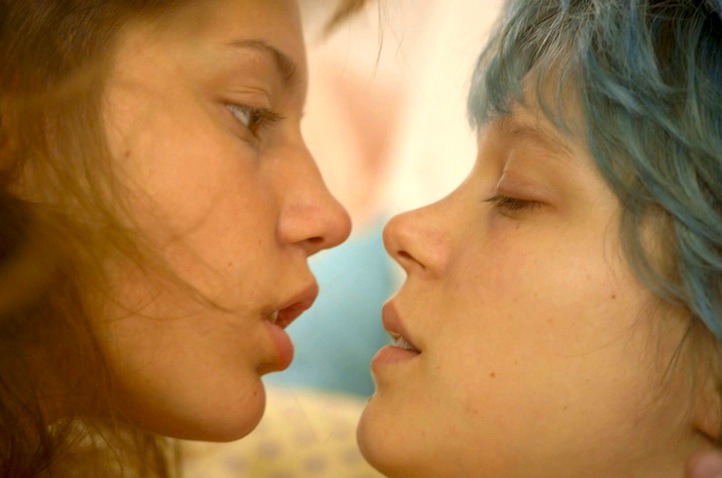
“Je suis femme. Et je raconte mon histoire.”
i.e. “I am a woman. And I tell my story”
The French title of the film, “La Vie d’Adéle – Chapitres 1 & 2” – literally translating into The Life of Adéle: Chapters 1 & 2”, directly referencing La Vie de Marianne (The Life of Marianne), an unfinished novel by Pierre de Marivaux that our messy-bunned Adéle (Adéle Exarchopoulus) is reading in high school French literature class. Class (in both senses of the term) is important in this film.
Boys express interest in her. Her friends keep bothering her about it. She expresses momentary romantic exchanges with both sexes- being more intrigued by her kiss with a female classmate than sex with a male one. At the 12 minute marker, Adéle passes by a beautiful blue-haired woman with a perfectly tooth-gapped smile and her arm around another girl. Holding herself like James Dean or Marlon Brando (who of which Léa Seydoux modelled herself after), the girl and Adéle make heavy eye contact (don’t they all?) and she makes enough of an impact that Adéle utilises her image in her masturbatory fantasies.
Interestingly enough, the first time they pass each other to a hundred takes until Kechiche was satisfied. Cut to when Adéle is at a gay bar with her gay friends, surrounded by all things- well, gay. Her sudden emergence into the rainbow world that is LGBTQ+ nightclubbing shrouds her. Everyone can tell she’s never been here before. Adéle actively looks around for blue hair. They find each other, share a strawberry milk, and the rest is their epic love story told throughout a couple of years.
With a definite paint-me-like-one-of-your-French-girls moment, discussions of Sartre and Schiele, lots of mussels and spaghetti, and many sex scenes (with the ratio being 15:180 minutes), the experiences of the Adéle and Emma breathe a strange kind of realism. Their conversation turns (that is: the way their sentences finish, pause, and continue) are something out of real life.
Films are normally designed and cut down to make every piece of dialogue purposeful, Kechiche relishes in the natural element of conversation. So when Adéle forgets what she was saying, or accidentally interrupts someone – we feel something that is often absent. In fact, much of the B-roll footage of the actress out of character was used in the film and since everyone off-camera was calling her by her real name Adéle, the character’s original name of Clementine was changed.
Based on the French graphic novel by Julie Maroh, the film premiered at Cannes to simultaneous cheers of joy and criticism. The judging panel which included Steven Spielberg, Ang Lee, and Nicole Kidman, made an exceptional move to award the Palme d’Or not only to the director, but to the two main actresses as well for the first time ever.
Spielberg commented; “The film is a great love story that made us feel privileged to be a fly on the wall, to see a story of deep love and deep heartbreak evolve from the beginning. The director did not put any constraints on the narrative and we were absolutely spellbound by the amazing performances of the two actresses, and especially the way the director observed his characters and just let them breathe.”
With over 800 hours of footage shot (I can only image the ratio of how much of that was simulated sex), Kechiche’s intense directorial style has been described as borderline abusive. Unfortunate, considering the film’s heart. Both actresses have stated that they really struggled and do not wish to work with him again.
14. Mulholland Dr. (2001) dir. David Lynch
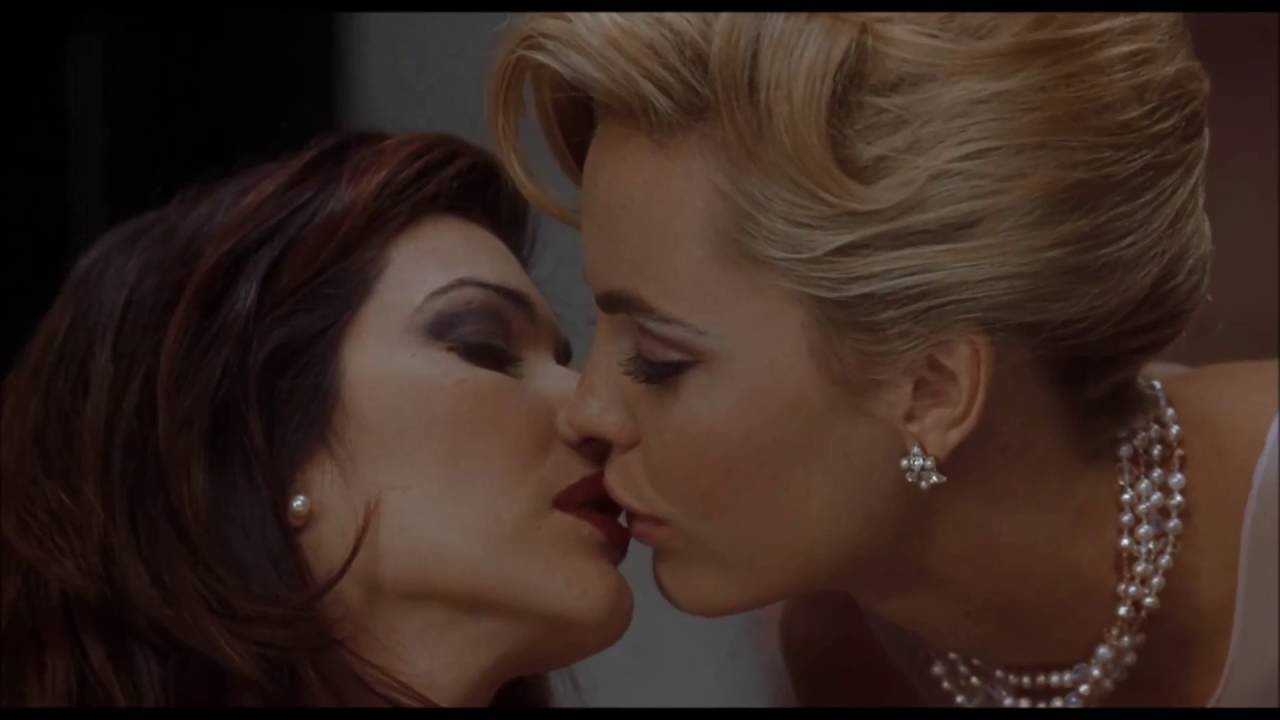
“They say intuition gives you an inner knowing, but the weird thing about inner knowing is that it’s really hard to communicate that to someone else. As soon as you try, you realise that you don’t have words, or the ability to say that inner knowing to your friend. But you still know it! It’s really frustrating. I think you can’t communicate it because the knowing is too beautifully abstract… I think people know what Mullholland Drive is to them but they don’t trust it. They want to have someone else tell them. I love people analysing it but they don’t need me to help them out. That’s the beautiful thing, to figure things out as a detective. Telling them robs them of the joy of thinking through and feeling it through and coming to a conclusion” – David Lynch (p.287-288, Lynch on Lynch).
This is the famously enigmatic and truthfully existential Mulholland Drive, all ready to be analysed into a neat little blue box, packaged with a bow. Beginning with a relatively idiosyncratic narrative (for Lynch atleast), a nameless woman (Laura Harring; who later adopts the name Rita for herself after seeing a Gilda poster) emerges from a car crash on dreamy Hollywood’s Mulholland Dr., absent of any expository memories. She sneaks into an apartment and hides from the wreckage – where she meets Betty (Naomi Watts), a blooming actress who helps her in the quest to discover her identity.
And, of course, the two fall in love. And, of course, this being Lynch, it’s barely as simple as that. The neo-noir is split into two distinct sections; the Betty and Rita love story, and the Diane and Camilla unrequited love story. Both played by the same respective actresses; Diane is Betty and Camilla is Rita, or is it the other way round?
The first part is marked by wonder, optimism, intrigue – success in love and auditions. This is the Lancanian fantasy. The second part (i.e. the last third of the film) is stained by rejection and atemporal fragments seemingly caused by psychological self-preservation – undermining its coherence. The sweet relationship between Betty and Rita turns into what we worry might be the truth of the reality, that is; Diane loving Camilla, but Camilla not reciprocating her desire.
In ‘reality’, she endures the harsh sight of her love interest openly flaunting her affection for other men and women, denying her the lipstick-stained kisses she alluringly provides others with. The abject desire is therefore turned and materialised in the form of the first two-thirds of the film, where Diane is no longer a suicidal, failing actress who is the subject of pity in others eyes – she becomes the saviour to Rita and finally feels that she is deserving of her affection. Betty is actually Diane’s own ideal ego, and the first part of the film where lesbian romance is achieved, perhaps, is only a reimagining of the unrequited love of movie star Camilla Rhodes. “This is the girl”, after all.
“More evocative than sensible… By combining sense with the texture of fantasy, Lynch uses the first part of Mullholland Drive to explore the role that fantasy has in rendering our experience coherent and meaningful… Diane’s fantasy transforms Camilla Rhodes, the impossible object, into Rita, the mysterious object. This transformation offers Diane an escape from the impossibility of the object-cause of desire.” – TM
Owing a debt of gratitude to Billy Wilder’s film noir “Sunset Boulevard” (in fact, at the Winkie’s Diner, the eponymous tag is labelled with the stylised title), as well as Bergman’s queer-esque “Persona”, another psychological drama which also focuses on the ever-ambigufying identities of the female couple. Lynch’s mystery film serves as a femme companion piece to his previous neo-noir “Lost Highway” (1997), adopting the film’s spiralling möbius strip approach by utilising a psychogenic fugue state.
“As we’ve seen in other Lynch films, this separation between the experience of desire and that of fantasy account for – and is accomplished by – dramatic changes in mise-en-scéne, editing, and the overall character of the shots between the first and second parts of the film.” – TM
For Lynch (and Mikey Waters), there’s something about roads. Wild at Heart, The Straight Story, Lost Highway, as well as his music video for Lykke Li’s dream pop song “I’m Waiting Here” all place significant attention of the road. A Fellini-La-Strada-inspired Lynch states; “A road, I’ve been thinking, is a moving forward into the unknown, and that’s compelling to me. That’s also what films are – the lights go down, the curtain opens and away were go, but we don’t know where we’re going” (p.269).
Indeed, the red velvet curtains are drawn and the spotlight is on as our female fantasy collapses. Rebekah Del Rio sings a Spanish version of Roy Orbison’s song “Crying”. And now the fantasy world is closing in on its edge. The world is becoming darker as we mourn the entity of love that was never truly fully provided in the first (or second) place. Betty picks up the enigmatic blue box that seemingly splits ‘fantasticism’ from dissatisfying reality, and now- she’s Diane. Idolised, but still queer. Silencio.
Literary references:
– Chris Rodley. Lynch on Lynch (2005; revised edition).
– Todd McGowan. The Impossible David Lynch (2007).
15. 120 BPM (Beats per Minute) (2017) dir. Robin Campillo
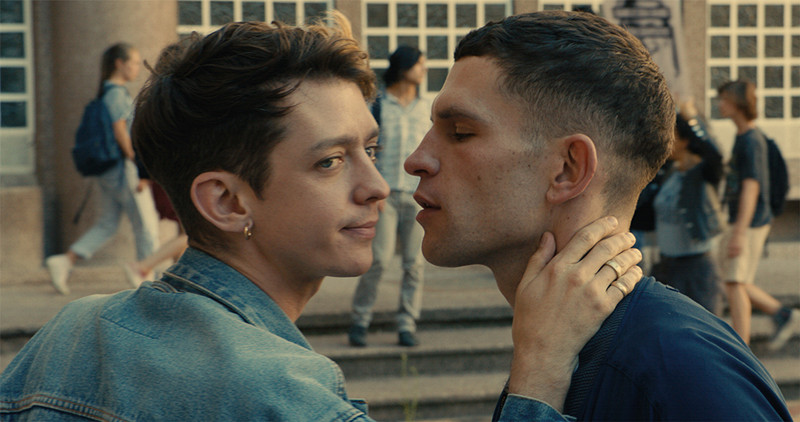
“This could be my last gay pride.”
Robin Campillo’s 120 battements par minute took Cannes by storm last year, winning both the Grand Prix, Queer Palm and more. This period ‘90s piece focuses on the AIDS epidemic experienced in France. Inspired by their own personal activist experiences, Campillo and co-writer Phillipe Mangeot solidify their characters within the hostile context of political campaigning against the failures of the government and the pharmaceutical industry to expedite necessary research into HIV cure and prevention.
We follow denim-clad, HIV-positive Sean Dalmazo (Nahuel Pérez Biscayart) and other courageous members of the Parisian ACT UP, an activist group in the gay community aimed at defending the rights of people with AIDS. The weekly meetings are every Tuesday at 7pm and involve a lot of debating, arguing, brainstorming and best of all: expressing approval by the snapping of fingers (rather than clapping) so that it won’t drown out speakers or delay important discussions – of which there are many. Whether it’s about medicine side-effects, dissemination of new research, or the mechanics of making fake-blood-filled-balloons, they discuss what everyone in power refuse to talk about. And in this film, as it was and is in life, silence = mort.
New member, HIV-negative Nathan (Arnaud Valois) is keen to learn what is so difficult to find out from the media. At a high school demonstration where the group bursts into classrooms, spreading safe-sex literature and condoms, Sean kisses the close-by Nathan to prove a point to an annoying girl who refuses to believe that AIDs has the potential to affect everyone and insults them for their orientation. And afterwards, Nathan beams something extraordinary. They soon pursue a relationship together, compellingly marked by barely represented gerodiscordancy.
The film is punctuated by intermittent dance sequences in a dark club with glimmers of multi-coloured strobe lights. The beats of the surround sound vibrate. The sad, angry group dancing away their vein-popping frustration at their situation, and ever-growing fear. “In the dance scenes, we hear one of Campillo’s favourite tracks of 1992, ‘What About This Love (KenLou mix)’.
It’s perhaps the moment where the ‘BPM’ in the title of the film makes the most sense, the beat of the music merging with an implicit pumping of hearts, all of which is a preamble to sex. Campillo notes, somewhat mysteriously, of these scenes, “We were the future ghosts of ourselves” (RC). The film’s technic soundtrack stitches the film together through anthem-like EDM beats.
Dust particles decorate the air, virus-like bodies grow and move, the Seine runs wildly with crimson blood. Bodies upon bodies lay on the ground to represent the dead. And there’s a Schrödinger’s cat mentality that people have about their past friends’ statuses. Not with regards to poz or neg, but whether they’re dead or not. In other words, this beautiful film is heavy, but it lives through the sporadic happiness of the community.
The drama won very big at the Césars in France, with Campillo winning Best Film, Best Original Screenplay and Best Editing, while also being nominated for Best Director. Both our male leads took home acting awards and Arnaud Rebotini rightfully won Best Original Music.
(Bonus: Campillo also directed gay-themed “Eastern Boys” (2013), a film which also utilises the power of invasion).
Literary References:
– Roger Clarke. The Body Politic. Sight and Sound, 28(5) – May, 2018.
16. The Way He Looks (2014) dir. Daniel Ribeiro
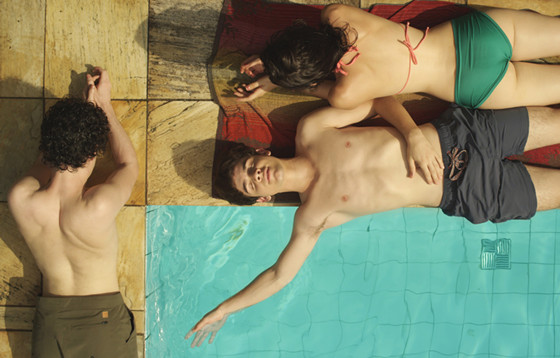
Gabriel: “Have you always been like this, Leo?”
Leo:” Always, I was born this way.”
The original Portuguese title, Hoje Eu Quero Voltar Sozinho, literally translates into ‘Today I Want to Go Back Alone’. Who is the ‘I’ you ask? His name is Leonardo, or rather just simply ‘Leo’ (Ghilherme Lobo), a Brazilian high-school student who hates sunscreen, only listens to classical music, and has yet to have his first kiss (unless you count mouthing steamy shower screens).
We open with a beautifully intriguing geometrically high-angle shot overlooking Leo and his best friend Giovana (Tess Amorim) lazing near her pool at the end of their summer holidays. Giovana is unsatisfied with the lack of excitement in their lives and longs for dramatic romances with- whoever. Leo on the other hand strives for something different- for independence and liberation from his restrictive routine (hence, the original title). Leo’s eyes lie straight ahead, never looking at Giovana. Giovana goes underwater, and Leo continues talking until he realises she has not responded, calling out her name – and we figure out that Leo’s blind.
School starts and Leo’s classmates make fun of him and the elevator-reminiscent ringing sounds his Perkins Brailler (i.e. braille typewriter) makes. Nobody wants to even sit behind him because of it, until- knock knock- enter curly-haired new-kid Gabriel (Fabio Audi) who takes up the only free seat.
Asking for erasers leads to joining Leo and Gio on their daily walking commute back home and soon the newbie becomes part of their little sunbathing-by-the-pool clique. Since Gabriel lives closer to Leo and is his new Spartan-project partner, he takes over the role of walking him home from Giovani. Leo locks his arm on to his, skin on skin. Gabriel’s somewhat sweet obliviousness to the fact that Leo can’t see spurs novel escapades that break Leo’s monotony and sparks interests never before considered.
Leo watches movies through Gabriel’s narrating voice, he listens and nearly-dances to music that wasn’t made before the 20th century, with Gabriel holding on to his shoulders, guiding his footsteps to mirror something similar to rhythm. He experiences his first eclipse through Gabriel tactilely explaining the process by guiding his hands over rocks representing the sun, the earth, and the moon. He clutches onto Gabriel’s shoulders as he rides on the back of his bicycle. Every touch is amped and we know where this is going.
What happens when someone you have ambiguously romantic feelings for leaves an article of clothing laying about? It happens in Call Me By Your Name, in Heartbeats, in Closet Monster, and communicates Leo’s developing feelings for Gabriel in this coming-of-age romance. It’s all about wearing it and inhaling the scent of (fill in the blank here) and touching oneself, or at least thinking about it. A culmination of olfactory and palpable sensations, sight is not necessary to explore feelings of sexual attraction of the same-sex and masturbate the anxiety of potential rejection away.
In 2010, Ribeiro released his seventeen-minute short film I Don’t Want to Go Back Alone (Eu Não Quero Voltar Sozinho), on which this film was originally based upon. It won the 2011 Iris Prize, an acclaimed prize from the international LGBTQ+ film competition of the same name. The condensed story feels very similar to its subsequent feature, but now Ribeiro has time to fully develop Leo as he not only discovers his own feelings regarding Gabriel, but also about himself.
The Way He Looks is currently available on Netflix.
17. Thelma (2017) dir. Joachim Trier

A father and daughter are in the woods, apparently hunting deer. One’s in sight. The girl looks. The father, though, the father points his rifle at the girl. After a couple of beats when the deer runs off, he puts the rifle down, and the film begins.
Studying at an Oslo university, Thelma (Eili Harboe) receives multiple phone calls from her strict, Christian parents daily. They track her Facebook and time schedule and seem overly protective of their daughter, who is now in college. We feel something is amiss in this situation.
Triggered by a bird flying smack into a glass window in the library and perhaps, the presence of a beautiful girl sitting down next to her, Thelma violently seizes for the first time ever, while more and more birds crash into the glass. The Doctor looks into this.
At the cavernous swimming pool, the aforementioned beautiful girl – Anja (Kaya Wilkins) – introduces herself to Thelma, asks if she’s feeling better and subsequently adds her on Facebook. This leads to Thelma going through all her photos. Photos with girls. Closer looking photos with boys. The two soon become friends, although everyone knows there’s a hefty layer of attraction buried beneath the frozen-over lake. The way they look at each other is enough to know this isn’t a platonic friendship. It’s something more.
Like C.R.A.Z.Y, this film is driven by raging internal turmoil and Freudian-like hysteria over Catholic guilt. You know, the burn for all eternity thing. Thelma recounts her father grabbing her hand and putting it close enough to a burning flame for her to feel the fire’s aggression.
“That’s what Hell is like all the time.”
How can Thelma let herself feel for Anja when this is the perceived result?
Shots that uncomfortable hold on for a little too long after they’ve concluded, serpant dreams and an electronic score that sends currents through the spine- this is a supernatural film. Thelma is more powerful than the weak person she thinks herself to be. So strong, in fact, she’s dangerous. What if her parent’s strict rules were actually there for a reason? Is it a coincidence that the titled name of our protagonist originates from the Greek term for will and volition? I doubt it. Depravity inevitably rears its ugly head within this pure, Christian family.